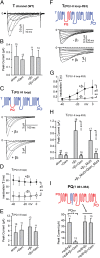Direct inhibition of P/Q-type voltage-gated Ca2+ channels by Gem does not require a direct Gem/Cavbeta interaction
- PMID: 20679232
- PMCID: PMC2930421
- DOI: 10.1073/pnas.1007543107
Direct inhibition of P/Q-type voltage-gated Ca2+ channels by Gem does not require a direct Gem/Cavbeta interaction
Abstract
The Rem, Rem2, Rad, and Gem/Kir (RGK) family of small GTP-binding proteins potently inhibits high voltage-activated (HVA) Ca(2+) channels, providing a powerful means of modulating neural, endocrine, and muscle functions. The molecular mechanisms of this inhibition are controversial and remain largely unclear. RGK proteins associate directly with Ca(2+) channel beta subunits (Ca(v)beta), and this interaction is widely thought to be essential for their inhibitory action. In this study, we investigate the molecular underpinnings of Gem inhibition of P/Q-type Ca(2+) channels. We find that a purified Gem protein markedly and acutely suppresses P/Q channel activity in inside-out membrane patches, that this action requires Ca(v)beta but not the Gem/Ca(v)beta interaction, and that Gem coimmunoprecipitates with the P/Q channel alpha(1) subunit (Ca(v)alpha(1)) in a Ca(v)beta-independent manner. By constructing chimeras between P/Q channels and Gem-insensitive low voltage-activated T-type channels, we identify a region encompassing transmembrane segments S1, S2, and S3 in the second homologous repeat of Ca(v)alpha(1) critical for Gem inhibition. Exchanging this region between P/Q and T channel Ca(v)alpha(1) abolishes Gem inhibition of P/Q channels and confers Ca(v)beta-dependent Gem inhibition to a chimeric T channel that also carries the P/Q I-II loop (a cytoplasmic region of Ca(v)alpha(1) that binds Ca(v)beta). Our results challenge the prevailing view regarding the role of Ca(v)beta in RGK inhibition of high voltage-activated Ca(2+) channels and prompt a paradigm in which Gem directly binds and inhibits Ca(v)beta-primed Ca(v)alpha(1) on the plasma membrane.
Conflict of interest statement
The authors declare no conflict of interest.
Figures





Similar articles
-
Molecular determinants of Gem protein inhibition of P/Q-type Ca2+ channels.J Biol Chem. 2012 Jun 29;287(27):22749-58. doi: 10.1074/jbc.M111.291872. Epub 2012 May 15. J Biol Chem. 2012. PMID: 22589533 Free PMC article.
-
RGK GTPase-dependent CaV2.1 Ca2+ channel inhibition is independent of CaVbeta-subunit-induced current potentiation.FASEB J. 2009 Aug;23(8):2627-38. doi: 10.1096/fj.08-122135. Epub 2009 Mar 30. FASEB J. 2009. PMID: 19332647
-
Direct inhibition of CaV2.3 by Gem is dynamin dependent and does not require a direct alfa/beta interaction.Biochem Biophys Res Commun. 2022 Jan 1;586:107-113. doi: 10.1016/j.bbrc.2021.11.052. Epub 2021 Nov 17. Biochem Biophys Res Commun. 2022. PMID: 34837834
-
Inhibition of Voltage-Gated Calcium Channels by RGK Proteins.Curr Mol Pharmacol. 2015;8(2):180-7. doi: 10.2174/1874467208666150507105613. Curr Mol Pharmacol. 2015. PMID: 25966691 Review.
-
Regulation of voltage-dependent calcium channels by RGK proteins.Biochim Biophys Acta. 2013 Jul;1828(7):1644-54. doi: 10.1016/j.bbamem.2012.10.005. Epub 2012 Oct 10. Biochim Biophys Acta. 2013. PMID: 23063948 Free PMC article. Review.
Cited by
-
Progress in the structural understanding of voltage-gated calcium channel (CaV) function and modulation.Channels (Austin). 2010 Nov-Dec;4(6):459-74. doi: 10.4161/chan.4.6.12867. Channels (Austin). 2010. PMID: 21139419 Free PMC article. Review.
-
Solution NMR and calorimetric analysis of Rem2 binding to the Ca2+ channel β4 subunit: a low affinity interaction is required for inhibition of Cav2.1 Ca2+ currents.FASEB J. 2015 May;29(5):1794-804. doi: 10.1096/fj.14-264499. Epub 2015 Jan 6. FASEB J. 2015. PMID: 25563298 Free PMC article.
-
A loss-of-function analysis reveals that endogenous Rem2 promotes functional glutamatergic synapse formation and restricts dendritic complexity.PLoS One. 2013 Aug 26;8(8):e74751. doi: 10.1371/journal.pone.0074751. eCollection 2013. PLoS One. 2013. PMID: 23991227 Free PMC article.
-
Molecular determinants of Gem protein inhibition of P/Q-type Ca2+ channels.J Biol Chem. 2012 Jun 29;287(27):22749-58. doi: 10.1074/jbc.M111.291872. Epub 2012 May 15. J Biol Chem. 2012. PMID: 22589533 Free PMC article.
-
Distinct RGK GTPases differentially use α1- and auxiliary β-binding-dependent mechanisms to inhibit CaV1.2/CaV2.2 channels.PLoS One. 2012;7(5):e37079. doi: 10.1371/journal.pone.0037079. Epub 2012 May 10. PLoS One. 2012. PMID: 22590648 Free PMC article.
References
-
- Catterall WA. Structure and regulation of voltage-gated Ca2+ channels. Annu Rev Cell Dev Biol. 2000;16:521–555. - PubMed
-
- Dolphin AC. β subunits of voltage-gated calcium channels. J Bioenerg Biomembr. 2003;35:599–620. - PubMed
-
- Maltez JM, Nunziato DA, Kim J, Pitt GS. Essential Ca(V)β modulatory properties are AID-independent. Nat Struct Mol Biol. 2005;12:372–377. - PubMed
Publication types
MeSH terms
Substances
Grants and funding
LinkOut - more resources
Full Text Sources
Molecular Biology Databases
Research Materials
Miscellaneous

